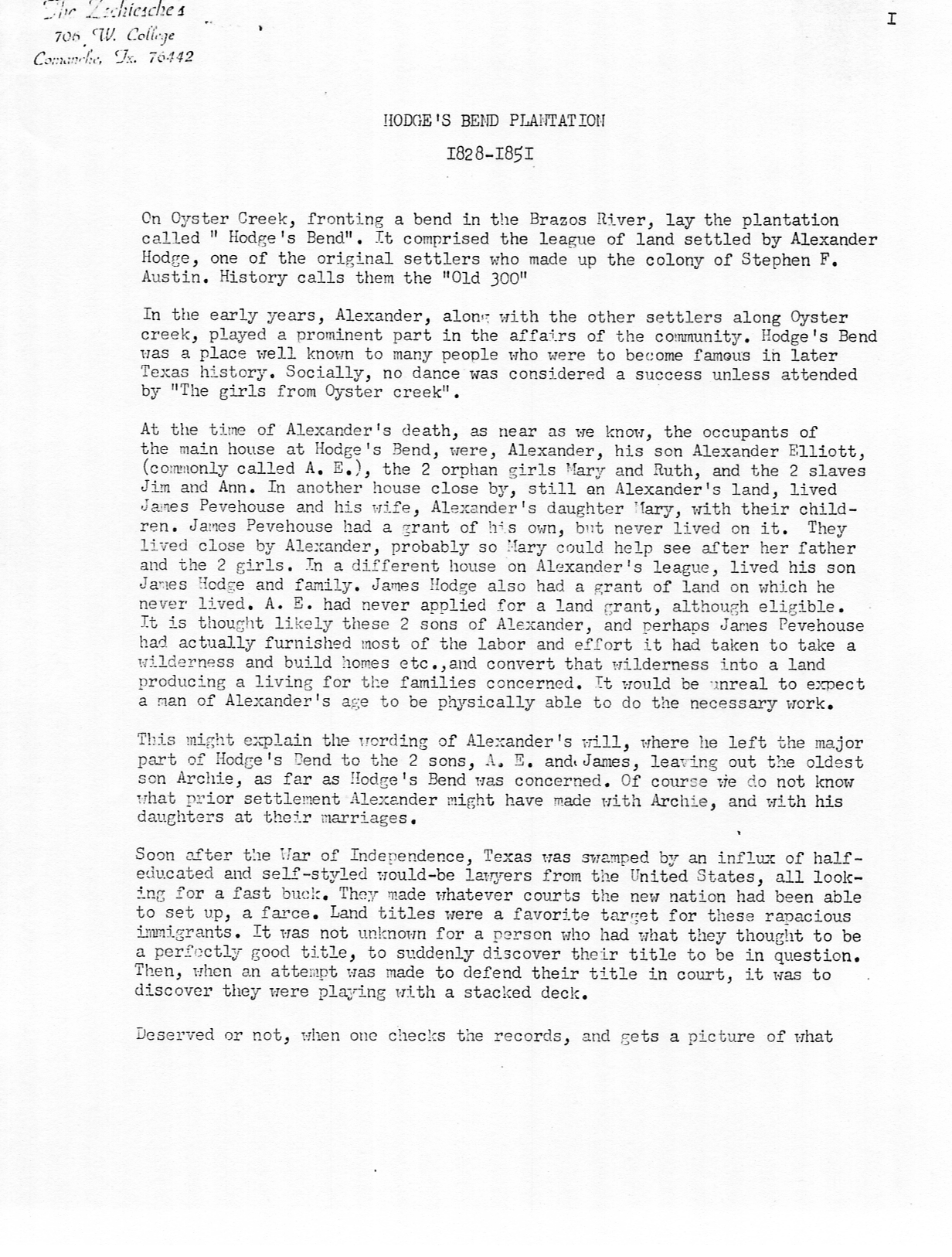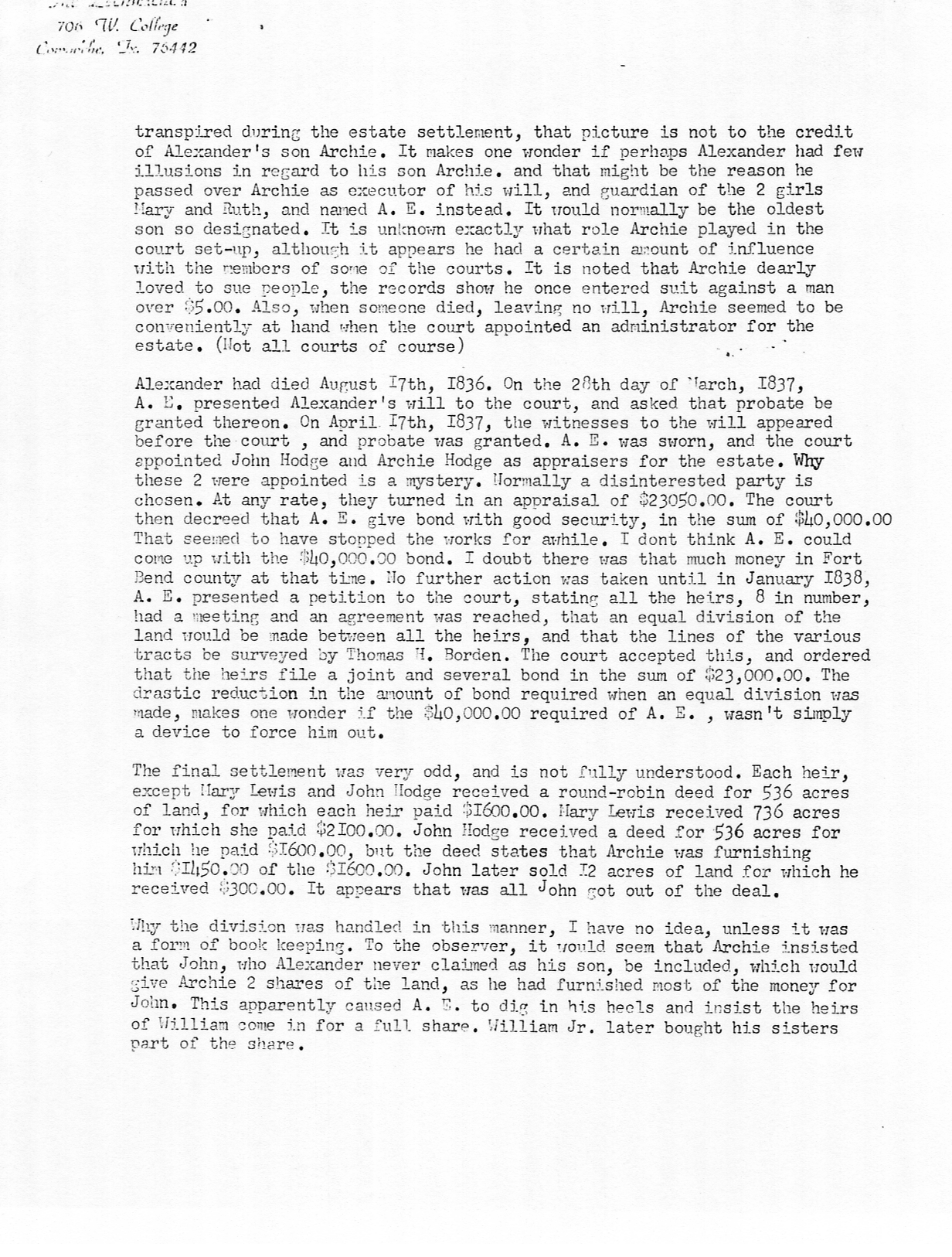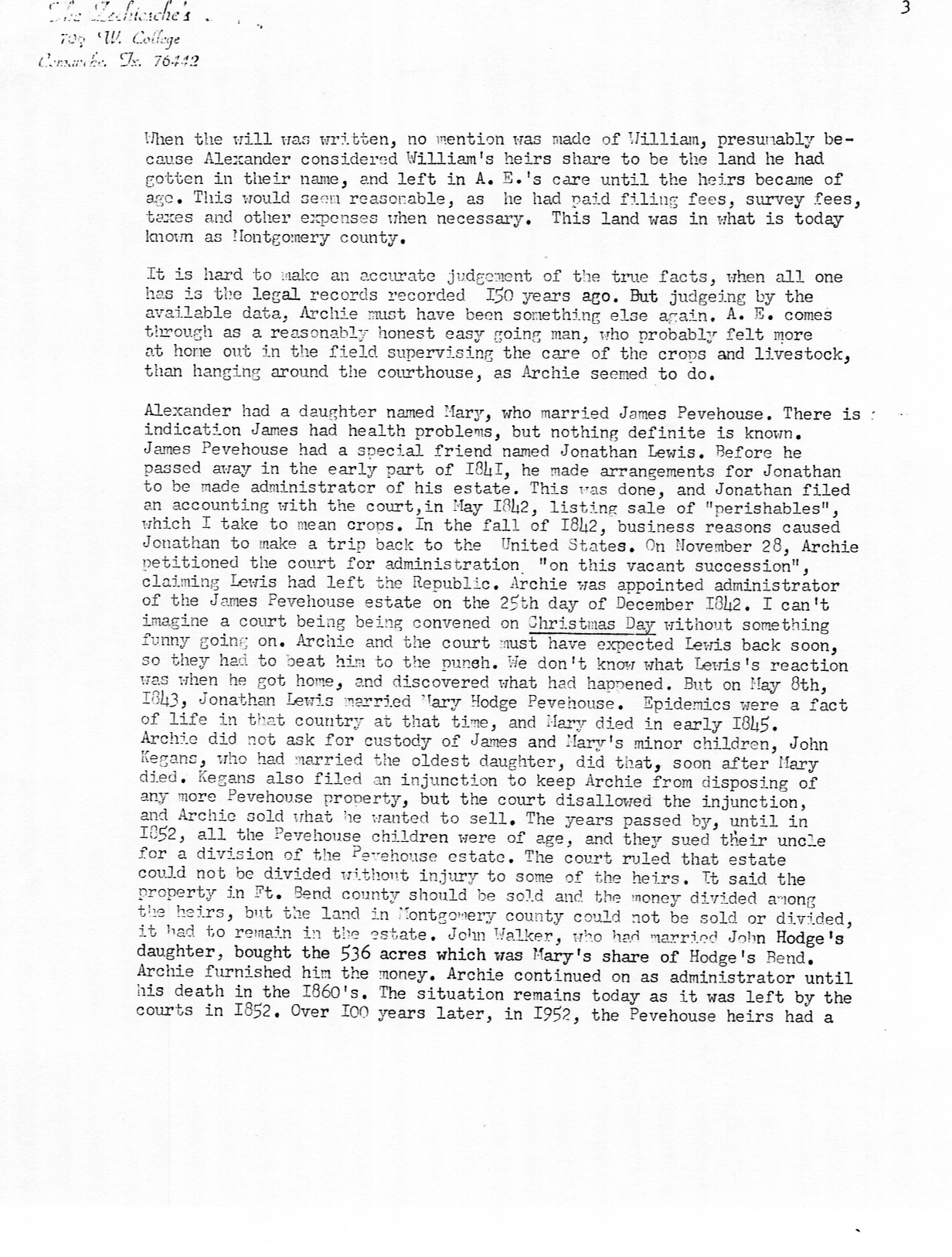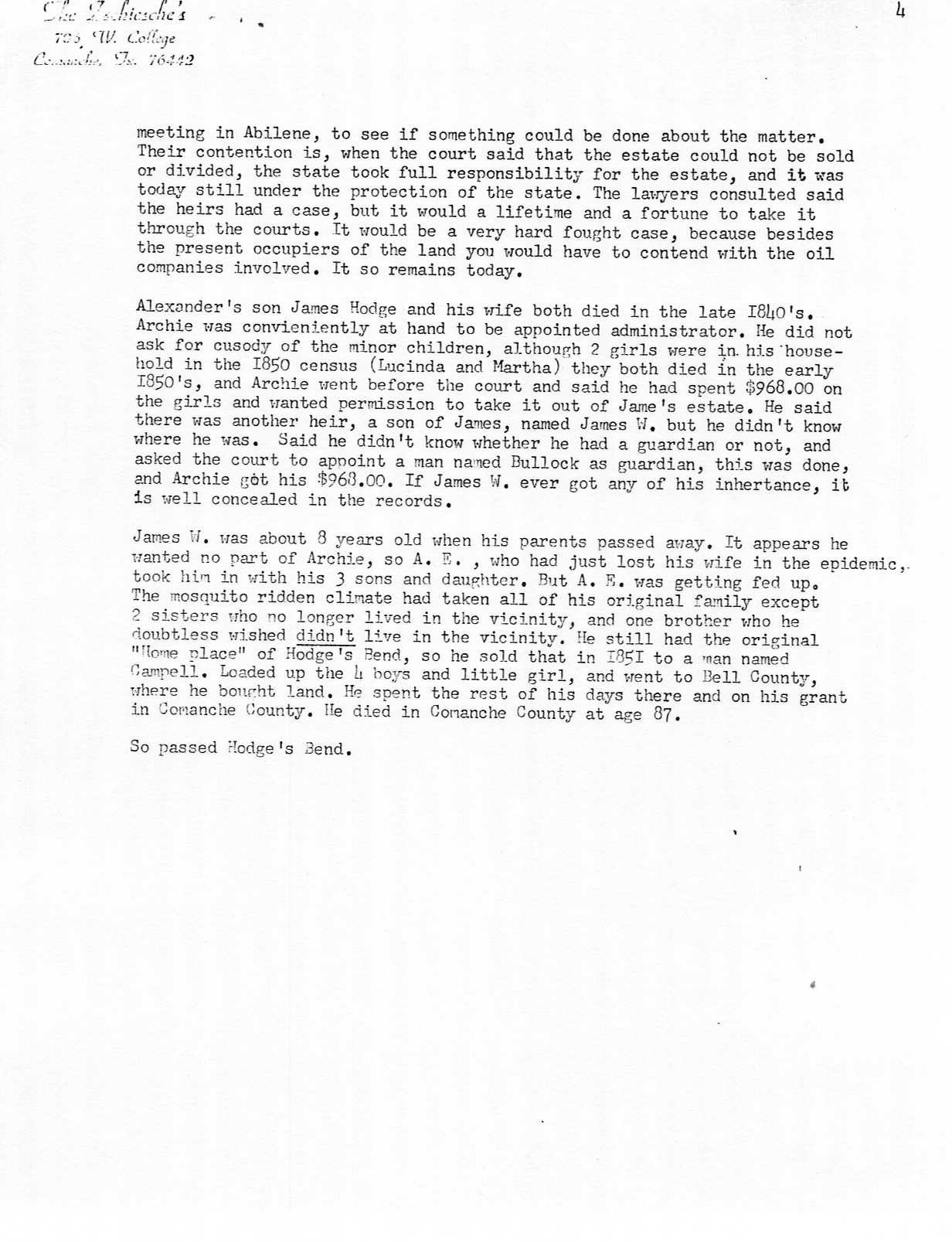Hodge's Bend Plantation - 1828-1851 by Mildred Zschiesche
(C. Avis Catalog entry #434)
(Document ID #618)
On Oyster Creek, fronting a bend in the Brazos River, lay the plantation called "Hodge's Bend". It comprised the league of land settled by Alexander Hodge, one of the original settlers who made up the colony of Stephen F. Austin. History calls them the "Old 300Ó. In the early years, Alexander, along with the other settlers along Oyster creek, played a prominent part in the affairs of the community. Hodge's Bend was a place well known to many people who were to become famous in later Texas history. Socially, no dance was considered a success unless attended by "The girls from Oyster creek".
At the time of Alexander's death, as near as we know, the occupants of the main house at Hodge's Bend, were, Alexander, his son Alexander Elliott, (commonly called A. E.), the 2 orphan girls Mary and Ruth, and the 2 slaves Jim and Ann. In another house close by, still an Alexander's land, lived James Pevehouse and his wife, Alexander's daughter Mary, with their children. James Pevehouse had a grant of his own, but never lived on it. They lived close by Alexander, probably so Mary could help see after her father and the 2 girls. In a different house on Alexander's league, lived his son James Hodge and family. James Hodge also had a grant of land on which he never lived. A. E. had never applied for a land grant, although eligible. It is thought likely these 2 sons of Alexander, and perhaps James Pevehouse had actually furnished most of the labor and effort it had taken to take a wilderness and build homes etc.,and convert that wilderness into a land producing a living for the families concerned. It would be unreal to expect a man of Alexander's age to be physically able to do the necessary work. This might explain the wording of Alexander's will, where he left the major part of Hodge's Bend to the 2 sons, A. E. and James, leaving out the oldest son Archie, as far as Hodge's Bend was concerned. Of course we do not know what prior settlement Alexander might have made with Archie, and with his daughters at their marriages.
Soon after the War of Independence, Texas was swamped by an influx of half-educated and self-styled would-be lawyers from the United States, all looking for a fast buck. They made whatever courts the new nation had been able to set up, a farce. Land titles were a favorite target for these rapacious immigrants. It was not unknown for a person who had what they thought to be a perfectly good title, to suddenly discover their title to be in question. Then, when an attempt was made to defend their title in court, it was to discover they were playing with a stacked deck. Deserved or not when one checks the records, and gets a picture of what transpired during the estate settlement, that picture is not to the credit of AlexanderÕs son Archie. It makes one wonder if perhaps Alexander had few illusions in regard to his son Archie. and that might be the reason he passed over Archie as executor of his will, and guardian of the 2 girls Mary and Ruth, and named A. E. instead. It would normally be the oldest son so designated. It is unknown exactly what role Archie played in the court set-up, although it appears he had a certain amount of influence with the members of some of the courts. It is noted that Archie dearly loved to sue people, the records show he once entered suit against a man over $5.00. Also, when someone died, leaving no will, Archie seemed to be conveniently at hand when the court appointed an administrator for the estate. (Not all courts of course).
Alexander had died August 17th 1836. On the 20th day of March, 1837, A. E. presented Alexander's will to the court, and asked that probate be granted thereon. On April 17th, 1837, the witnesses to the will appeared before the court , and probate was granted. A. E. was sworn, and the court appointed John Hodge and Archie Hodge as appraisers for the estate. Why these 2 were appointed is a mystery. Normally a disinterested party is chosen. At any rate, they turned in an appraisal of $23050.00. The court then decreed that A. E. give bond with good security, in the sum of $40,000.00 That seemed to have stopped the works for awhile. I don't think A. E. could come up with the $40,000.00 bond. I doubt there was that much money in Fort Bend county at that time. No further action was taken until in January 1838, A. E. presented a petition to the court, stating all the heirs, 8 in number had a meeting and an agreement was reached, that an equal division of the land would be made between all the heirs, and that the lines of the various tracts be surveyed by Thomas H. Borden. The court accepted this, and ordered that the heirs file a joint and several bond in the sum of $23,000.00. The drastic reduction in the amount of bond required when an equal division was made makes one wonder if the $,40,000.00 required of A. E. wasn't simply a device to force him out.
The final settlement was very odd, and is not fully understood. Each heir, except Mary Lewis and John Hodge received a round-robin deed for 536 acres of land, for which each heir paid $1600.00. Mary Lewis received 736 acres for which she paid $2100.00. John Hodge received a deed for 536 acres for which he paid $1600.00, but the deed states that Archie was furnishing him $1450.00 of the $1600.00. John later sold 12 acres of land for which he received $300,00. It appears that was all John got out of the deal.
Why the division was handled in this manner, I have no idea, unless it was a form of bookkeeping. To the observer, it would seem that Archie insisted that John, who Alexander never claimed as his son, be included, which would give Archie 2 shares of the land, as he had furnished most of the money for John. This apparently caused A. E. to dig in his heels and insist the heirs of William come in for a full share. William, Jr. later bought his sistersÕ part of the share.
When the will was written, no mention was made of William, presumably because Alexander considered William's heirs share to be the land he had gotten in their name, and left in A. E.'s care until the heirs became of age. This would seem reasonable, as he had paid filing fees, survey fees, taxes and other expenses when necessary. This land was in what is today known as Montgomery County. It is hard to make an accurate judgment of the true facts, when all one has is the legal records recorded 150 years ago. But judging by the available data, Archie must have been something else again. A. E. comes through as a reasonably honest easy going man, who probably felt more at home out in the field supervising the care of the crops and livestock, than hanging around the courthouse, as Archie seemed to do.
Alexander had a daughter named Mary, who married James Pevehouse. There is indication James had health problems, but nothing definite is known. James Pevehouse had a special friend named Jonathan Lewis. Before he passed away in the early part of 1841, he made arrangements for Jonathan to be made administrator of his estate. This was done, and Jonathan filed an accounting with the court,in May 1842, listing sale of "perishables", which I take to mean crops. In the fall of 1842, business reasons caused Jonathan to make a trip back to the United States. On November 28, Archie petitioned the court for administration "on this vacant succession", claiming Lewis had left the Republic. Archie was appointed administrator of the James Pevehouse estate on the 25th day of December 1842. I can't imagine a court being being convened on Christmas Day without something
funny going on. Archie and the court must have expected Lewis back soon, so they had to beat him to the punch. We don't know what Lewis' reaction was when he got home, and discovered what had happened. But on May 8th, 1843, Jonathan Lewis married Mary Hodge Pevehouse. Epidemics were a fact of life in that country at that time, and Mary died in early 1845.
Archie did not ask for custody of James and Mary's minor children, John Kegans, who had married the oldest daughter, did that, soon after Mary died. Kegans also filed an injunction to keep Archie from disposing of any more Pevehouse property, but the court disallowed the injunction, and Archie sold what he wanted to sell. The years passed by, until in 1852, all the Pevehouse children were of age, and they sued their uncle for a division of the Pevehouse estate. The court ruled that estate could not be divided without injury to some of the heirs. It said the property in Ft. Bend County should be sold and the money divided among the heirs, but the land in Montgomery County could not be sold or divided, it had to remain in the estate. John Walker, who had married John Hodge's daughter, bought the 536 acres which was Mary's share of Hodge's Bend. Archie furnished him the money. Archie continued on as administrator until his death in the 1860's. The situation remains today as it was left by the courts in 1852. Over 100 years later, in 1952, the Pevehouse heirs had a meeting in Abilene, to see if something could be done about the matter,
Their contention is, when the court said that the estate could not be sold or divided, the State took full responsibility for the estate, and it was today still under the protection of the State. The lawyers consulted said the heirs had a case, but it would a take lifetime and a fortune to take it through the courts. It would be a very hard fought case, because besides the present occupiers of the land you would have to contend with the oil companies involved. It so remains today.
Alexander's son James Hodge and his wife both died in the late 1840's. Archie was conveniently at hand to be appointed administrator. He did not ask for custody of the minor children, although 2 girls were in his household in the 1850 census (Lucinda and Martha) they both died in the early 1850's, and Archie went before the court and said he had spent $968.00 on the girls and wanted permission to take it out of James' estate. He said there was another heir, a son of James, named James W. but he didn't know where he was. Said he didn't know whether he had a guardian or not, and asked the court to appoint a man named Bullock as guardian, this was done, and Archie got his $968.00. If James W. ever got any of his inheritance, it is well concealed in the records.
James W. was about 8 years old when his parents passed away. It appears he wanted no part of Archie, so A. E., who had just lost his wife in the epidemic, took him with his 3 sons and daughter. But A. E. was getting fed up The mosquito-ridden climate had taken all of his original family except 2 sisters who no longer lived in the vicinity, and one brother who he doubtless wished didn't live in the vicinity. He still had the original "Home place" of Hodge's Bend, so he sold that in 1851 to a man named Campell. Loaded up the boys and little girl, and went to Bell County, where he bought land. He spent the rest of his days there and on his grant in Comanche County. He died in Comanche County at age 87.
So passed Hodge's Bend.




